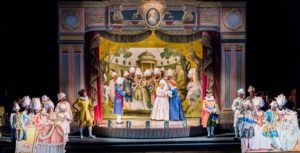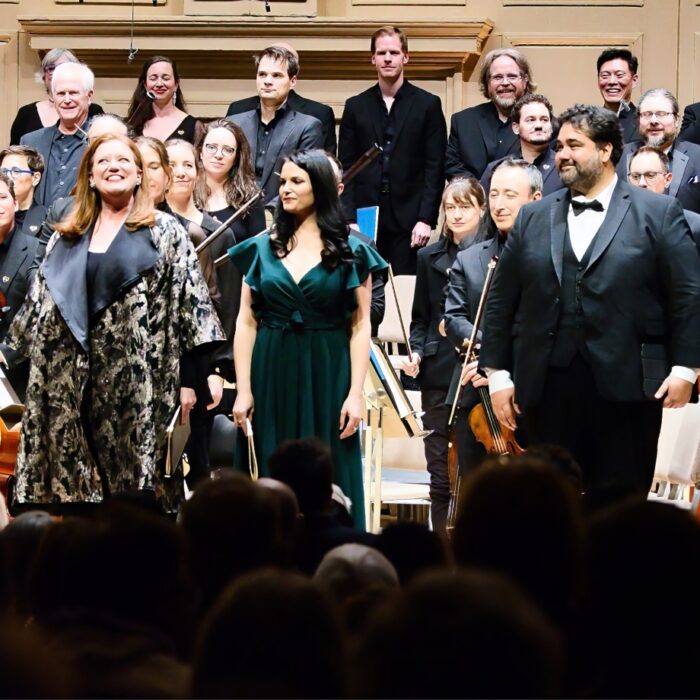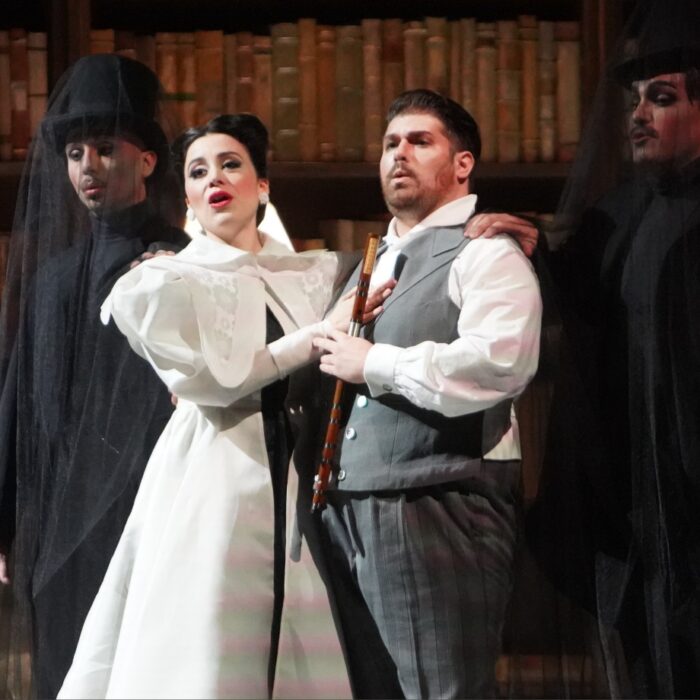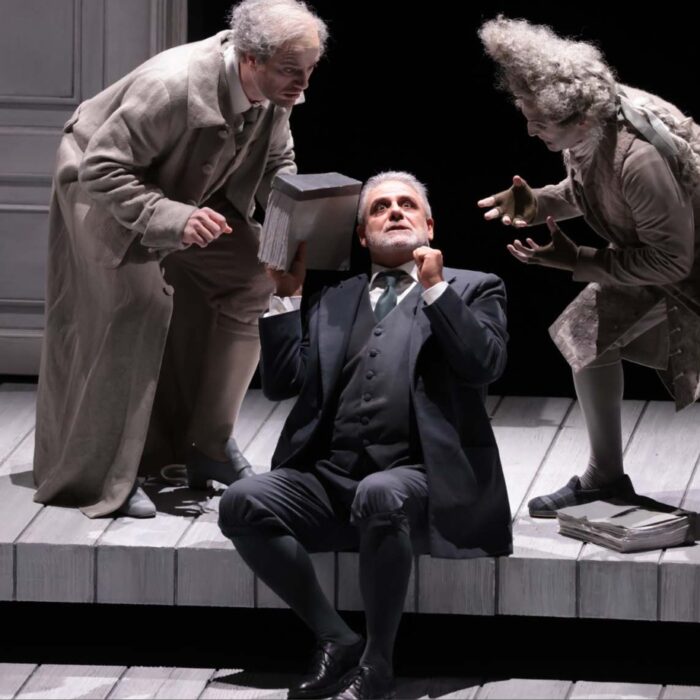
Donizetti Opera Festival 2018 Review: Enrico Di Borgogna
By Alan NeilsonIs it possible to create a first-rate theatrical experience when staging an opera in which the composer has not yet found his feet?
The question is asked in response to the Donizetti Opera Festival’s decision to mount a production of “Enrico di Borgogna,” the composer’s second complete opera and the first of his works to be given a staging premiered at the Teatro San Luca, Venice in 1818. Being the 200th anniversary of Donizetti’s operatic debut, it appears to be an obvious choice for inclusion in this year’s festival. However, the work is a piece of Donizetti juvenilia, and while it is clear that Donizetti is attempting to develop his own style, the heavy influence of Rossini is never far away. Moreover, the work defined as an “opera semi-sera” is problematic, for although the mixing of serious drama with comedic themes and characters was not unusual, in this case, the balance is completely wrong. Gilberto is a classic buffo character, but with a large role, whilst the part of Enrico, played by a mezzo-soprano, is more of a heroic character, all of which is not so usual and disrupts the dramatic tension as well as undermining its credibility.
The narrative is fairly straightforward. Enrico is the heir to a dukedom, but as a small child, his father was killed by a usurper, who has himself just died and been succeeded by his son, Guido. It is time for Enrico to regain his inheritance, so he plans to lead an assault on Guido’s castle. By chance, Guido is about to marry Elisa, whom Enrico also loves. Fortunately, he arrives just in time, stops the marriage and regains his inheritance.
A Vital Production
In what amounted to a stroke of theatrical genius, Silvia Paoli, the director, took the bold and imaginative decision to turn the whole performance into a comedy – and it worked brilliantly! This was not the normal opera comedy, which elicits the occasional smile from the audience, but a genuinely funny presentation, which had the audience laughing out loud. Everything was treated as a source of fun, from the narrative, and its mix of characters through the theatrical conventions of the time, even poking fun at the singers themselves. It was all staged in a blaze of color, fast-moving action, fabulous costumes and cleverly managed extraneous silliness.
Paoli, along with Andrea Belli, the stage designer, created an on-stage theater, actually the Teatro Luca in Venice, which was presenting a performance of Donizetti’s opera “Enrico Borgogna.” It was set on a rotating platform so that the audience could also see what was going on behind the scenes. Props and scenery for the San Luca were brightly colored, consistent with the period, and of course all wonderfully amateur by today’s standards.
In the production within the made up theater problems did arise during the overture, as they were one male short, so, therefore, had to cast the role of Enrico as a woman, much to her disgust, who put up a certain resistance to the idea. There was also an actor in a bear costume who insisted on having a part, much to the annoyance of the theater manager who did his best to haul him off the stage every time he joined in the performance. In fact, this was not the most well-behaved cast, who offstage were always involving themselves in some sort of outrageous goings-on. They, nevertheless, acted out their roles professionally when on stage, at least almost always; Elisa having delivered an aria, swoons, but on hearing the audience’s applause quickly recovers to acknowledge their approval, before exaggeratedly re-swooning. And there was Gilberto, the buffo role, who appeared free to do as he pleased.
To ensure that the production of “Enrico Borgogna” was up to standard, Paoli referred to Antonio Morrocchesi’s 1832 book, “Lezioni di declamazione e d’arte teatrale” to ensure that the correct gestures were used by the actors, so for example, sadness would be a raised arm across the forehead, with the upper body half turned, with the other arm stretched out away from the direction of the face. It made everything so much easier to follow, especially during the ensembles in which the characters could clearly communicate their individual emotions.
It was also marvelously over the top, and very funny. Sitting in the audience, one had the impression that the director, the production team as wells as the cast had great fun in thinking up more gags that could be used.
The costumes, designed by Valeria Donata Bettella, were nicely coordinated to match the spirit of the presentation, in a nice blend of traditional period attire and flamboyant extravagance to highlight the comedy of the production. The lighting designer, Fiammetta Baldiserri, flooded the Teatro San Luca with bright colors, keeping the atmosphere light and cheery, for most of the performance.
A Star Cast
Despite her initial reluctance to play the male role of Enrico, the mezzo-soprano, Anna Bonitatibus, proved to be more than up to the task, putting in an accomplished performance. Her voice has a refined quality, which not only lies easily on the ear, but one Bonitatibus used intelligently to craft a strong vocal portrait of the hero. Her well-grounded mezzo, with its rich dark timbre, shows a wonderful degree of consistency and agility. Throughout the evening she impressed, whether shaping finely articulated recitatives, singing delicately embellished lines with a captivating legato or delivering a sparkling coloratura display, she oozed quality. It was a first-class performance.
Francesco Castoro produced a sympathetic performance of Pietro, Enrico’s guardian. He sang with an easy, confident manner, his voice secure across the range, with an attractive timbre. His skillful phrasing, and ability to imbue the vocal line with subtle inflections allowed him to produce a convincing portrait of the character. Recitatives were also thoughtfully and meaningfully managed.
The mezzo-soprano, Sonia Ganassi, portrayed herself as the grand diva, playing the part of Elisa, and showed a natural gift for playing comedy roles. She has a strong, dynamically versatile and flexible voice which she is able to manage intelligently and with skill. Striding the stage with an air of feigned importance she gave a dramatic and over-dramatic performance, which captured both Ganassi as diva and Ganassi as Elisa.
Guido, supposedly an evil character, was played by Levy Sekgapane, who gave such an open and naïve interpretation, that it was not possible to take him as such. Certainly, his behavior was not virtuous, but he was subsumed into the general hilarity of the production. After all, anyone who is sharing a stage with a man in a bear suit cannot be too serious. Sekgapane impressed with his light, lyrical singing. There is a delightful balance to his voice, he possesses a flawless passaggio, with a bright upper register. It was a beautiful singing display, although he failed to inject, probably deliberately, any sense of latent danger into his vocal characterization.
Luca Tittoto gave a stunning interpretation in the buffo role of Gilberto. Dressed in very colorful yellow costumes, with a bright orange doubled horned wig, he certainly looked the part. Tittoto has obviously thoroughly absorbed the buffo character, his every gesture, facial expression, and movement was perfectly placed. This was backed up by an equally compelling vocal display, in which he delivered his recitatives with clarity, carefully positioned subtle inflections, with exactly the right emphases to ensure the maximum effect. Tittoto has an engaging bass, with an attractive timbre, which exhibits real depth.
Federica Vitali in the role of Geltrude proved herself to be an excellent comedy actress, really hamming up the role in fine style, and sporting a captivating hairstyle. Moreover, she used the role to show off her beautifully sounding soprano, which she used well in characterizing the role.
Lorenzo Barbieri, as Brunone, acquitted himself well, producing a lively and engaging performance. He possesses an attractive bass-baritone, and displayed ability in characterization, making the most of the relatively small role.
The tenor, Matteo Mezzaro, in the small role of Nicola, the peasant friend of Pietro, also performed well.
The members of the chorus, under the management of Fabio Tartari, really seemed to enjoy themselves, singing and acting their parts convincingly.
The Academia Montis Regalis, a period instrument orchestra, gave a splendid performance under the early music specialist, Alessandro De Marchi. Always responsive to the onstage drama, De Marchi was particularly attentive to its dramatic junctures. The use of period instruments also helped create the feeling that the audience was watching a production set in an early 19th-century theater, although the sound may not be one a modern day audience would normally associate with Donizetti.
Returning to the question as to whether it is possible to create a first-rate theatrical experience from an early immature work, the answer has to be an emphatic “Yes.” Although not the best of Donizetti’s works, “Enrico di Borgogna” has its moments, but this presentation was on an altogether higher level. Using the dramatic weaknesses of the opera to parody itself, it became a brilliantly funny and an engrossing piece of theater. Moreover, it was an excellent piece of scheduling by the Donizetti Opera Festival, for by lining it up alongside “Il Castello di Kenilworth” it created a balanced programme: the dark, serious psychologically intense set against the light, bright and humorous.


